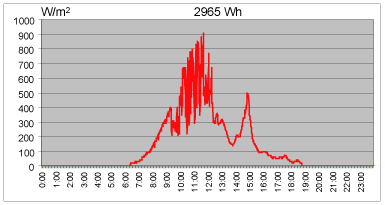Supplement
to the beer-collector
The previously reviewed collector was put to it's
planned place at the end of the winter of 2006, on the 21th of
February.
After this date there still came a lot of cold winterly day, which
allowed the registration of some useful observations.
When the review was written, only a weak centrifugal
fan was used to test the collector. This fan could blow 550-600 liter
of air in a minute in the device. At nice sunny, but cold weather, the
temperature raised above 70 °C (158 F) quite quickly at the supply
air-duct (to the room). I put this down as a big success. I only
mention the 70 °C (158 F), because I didn't have suitable temperature
sensor to measure higher temperatures at that time.
On the 6th of March, 2006 at 6:50 am the outer air temperature was -4 °C (24.8 F). The first ray of sunlight reached the collector approximately then and at 06:55 am I switched on the fan. These are the registered temperature values:
|
time |
t1 [°C - F] |
t2 [°C - F] |
|
7:00 |
18.2 °C - 64.7 F |
18.5 °C - 65.3 F |
|
7:15 |
18.7 °C - 65.7 F |
36.2 °C - 97.1 F |
|
7:30 |
18.5 °C - 65.3 F |
43.5 °C - 110.3 F |
|
7:45 |
18.2 °C - 64.7 F |
52.5 °C - 126.5 F |
|
8:00 |
18.5 °C - 64.7 F |
63.3 °C- 145.9 F |
|
8:10 |
18.7 °C - 65.7 F |
H |
Table 1
t1
: temperature of the air at the inlet tube (input of the collector)
t2
: temperature of the air at the effluent tube (output of the collector)
H : this is the thermometer's sign for the higher, than 70°C (158 F) temperatures
The result made me feel good, just when I started to
calculate, I got a little exasperated. Why? Because the measured
temperature difference of 51.3 °C (124.3 F) and the air flow of
0.589
m3/minute (20.8 cubic feet/minute) means 606 W on the full 3.5 m2 (37.6
sq. feet) of absorber area, so 173 W/m2. I reckoned this too small, not
worth enough to struggle for.
Since the Canadian people mentioned airflow of 2.5
m3/minute (150 m3/hour), I felt necessary to increase the flow rate. I
note that when I was searching for a fan of this air flow rate in a fan
shop, the expert shop assistant already considered the rate
unnecessarily high. On the internet topic (Napenergia
- Solar power) the same opinion shaped: the smaller the air flow
rate, the higher output temperature will be. So no need to install a
stronger fan.
I had a ventilating/heating fan disassembled from a car, I tried to use this. The fan was connected to a changeable output battery charger, so I could set gradually the voltage, so the rev of the fan engine and this way the rate of the airflow, in the range of 1 - 4 m3/minute.
A surprising result was the outcome. The bigger fan was put on the already warmed up collector. The airflow at least doubled. The collector didn't start to cool down!!! The temperature started to decrease after elapsing long time. I increased the air flow, and the temperature remained almost unchanged. I didn't understand at first. I thought, the thermometer is wrong. Several measures resulted much more energy output from the "beer-horse", as I supposed at the beginning!
In the meanwhile I got better thermometers which
could measure from the distance (separate sensor), I solved the quick
change of the fans, and retired the small fan, with admitting it's
deserts.
The next table points out the difference (of the
gained energy) between the two fans:
|
|
small fan |
big fan |
|
Temperature difference ( °C / F) |
52 / 93.3 |
37 / 66.6 |
|
airflow ( m3/minute ) |
0,589 |
3,17 |
|
momentary output power for the whole
collector ( W ) |
615,01 |
2357,31 |
|
momentary output power for 1 m2 of
the
collector ( W/m2 ) |
175,72 |
672,09 |
Table 2
Notice: the temperature difference is meant between
the inlet and the effluent tube of the collector. I measured the air
flow velocity by anemometer , and calculated the air flow rate from the
cross section of the tube.
The lesson is: with closely same conditions (outside
temperature, inlet air temperature) by increasing the air flow rate by
5.4, the temperature decreased 15 °C (27 F) , and the output power
increased by 3.8 times bigger!
This is something we have to pay attention to!
The collector is facing East, to be accurate the
normal line of the surface of the collector is directing 108 degree
from the North, so 18 degrees from the East toward he South. So the
rising Sun's first light can reach it, and the maximum power is gained
in one - one and a half hour. It is exposed to the Sun light until
12:30 am, and then it is shed by shadow. (It's being prepared pair will
use
the Sun's power in the remaining time of the day.)
About efficiency
The question is asked several times: what is the
efficiency of it? This is very hard to tell, because I don't have data
about the power of the sunshine at these early hours. The "Naplopó Kft"
has a sunshine power measurement device, they also publish the measured
data, but this device is measuring to a surface of 45 degree, and is
facing South.
(The "Naplopó kft"
is a firm in Hungary, kft = ltd (limited liability company) Look
at:
http://www.naplopo.hu/napsug.html )
The Hungarian word "Naplopó"
means "idler". Really it is a compound word, the first part is "Nap"
means the Sun and also the day, the second part "lopó" means thief, the
one who steals. So this word directly means: the one man who steals the
day (the time of the day, i.e. don't works, don't makes something
useful). But it can be also: the one, who steals the Sun, steals energy
from the Sun. :)
The next table (Figure 1.) contains data of the
collector measured at 04.04.2006. at noon, and I copy the measurements
of Naplopó kft into this table also. Taking account of the position of
the Sun, I determine the sun lit surface of the collector, and read the
number of sunshine graph at that moment, the result is 71.32% of
efficiency.
Figure 1
I did more of this kind of measurements, and the efficiency is getting better, as the temperature of the taken air (the output) is lower. So the insulation problems doesn't cause big losses - I could say, according to my observations, the well known fact is verificated.
As interesting fact I put here the graph of the air
flow drag of the collector (Figure 2).
From a transparent plastic tube I made a U tube
manometer, with coloured water in it, the end of the tube attached to
the inlet and the output tube of the collector, and measuring different
air flow velocities the difference of the water levels, which then I
converted to pressure difference. This graph can help choosing the
right fan.
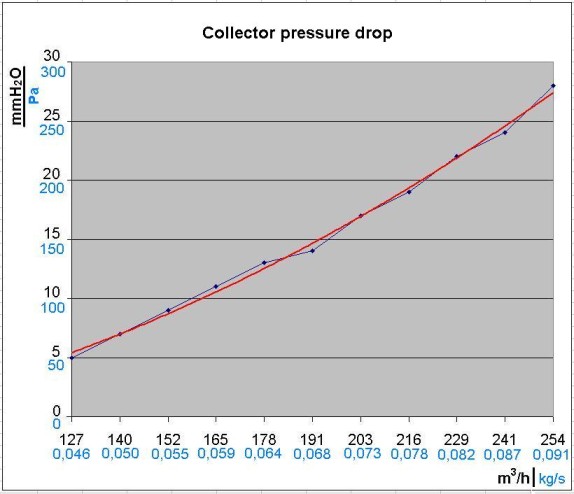 |
|
Figure 2 |
There is a same diagram at the Cansolair, and it is
very similar !
How much energy is produced by the collector ?
It was already the second half of April, when I
could perform this measurement. I succeed to measure the whole morning
from 07:45 am to 13:47 pm. on the 16th the first time.
The outside temperature was 7.7 °C at start, and it
was 16.8 °C at the end of the measurement (so this is considered as the
part of the heating season). Based upon 62 measured temperature data,
the gained energy was 23.33 MJoule = 6.49 kWh (1851 Wh for 1 m2),
the
"Naplopó Kft" (13 km from my position) measured this:
|
16th of April 2006. |
|
Figure 3 |
Disturbances on the red line shows, that the sunshine was not uncluttered.
The second measurement was done on the 22th of April
(with and based on the help and ideas of the topic). Webcamera made
shots of the thermometers in every minute. 301 measurements were done.
- - - - - - - - - - - - - - - - - - - - - - - - - - - - - - - - - - - -
- - - - - - - - - - - - - - - - - - - - - - - - - - - - - - - - - - - -
- - - - - - - - - - - -
Evaluated these in the period from 8:38 am till 15:12 pm I got 27.6 MJ
as the result output energy. Unfortunately at these measurements I
could only start one hour later, than planned, because of technical
reasons (the webcamera didn't start to work). If we correct the result
with the previously measurement's same period's (which was missing now,
because the late start) produced power, we have the result of 31.3 MJ =
8.69kWh (2484 Wh on 1m2).
The outside temperature was 15°C (59 F) at the start and 20.7°C (69.2 F) at the finishing of the measurement.
"Naplopó Kft" measured this:
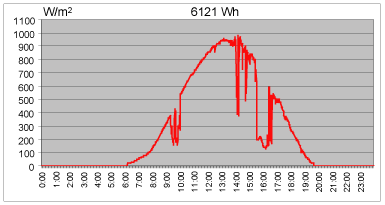 22nd of April 2006 |
|
Figure 4 |
Probably you notice, that the 22 April measurement
last till 15:12 pm, though I formerly wrote, that the collector is in
sunshine only until 12:30 am (summer time it means 13:30 pm). This is
because of the diffuse lighting of the Sun, the indirect light! On this
day, the diffuse light the collector produced 1.99 MJ energy !
Remarkable experience about the diffuse lighting:
When the Sun is not shining on the collector any more, when there are clouds on the sky shading the collector, the inside temperature of the collector remains significantly high for long. Sometime it remains until 16-18 pm. The regulator (thermostat) switches on frequently at this time also, and the fan keeps working for quite long: 10-15 minutes (now the air flow rate is 2.7 m3/minute). Then it stops and doesn't work for about the same period, and again switch on. This time the collector blows in 4 °C (7.2 F) warmer air, then the air temperature in the room, because I set the thermostat to this temperature difference. The fan consumes 42 W of power, and at 4 °C (7.2 F) temperature difference, the transferred heat power is 200 W. So the collector is still producing more power, than it consumes !
When the sky is clear, no clouds, then no diffuse light can be observed.
When there are some clouds on the sky, but there is
no sunshine, the collector still can produce some heat. At these times,
the collector's inside temperature is over 10-12 °C (18-22 F)
comparing to the air temperature of the room. Of course, the
collector switches on.
In totally cloudy conditions, nothing can be measured.
What else could it do ?
Since the fan has an air filter - mainly to avoid
the dust to get into the collector - it also filters the air of the
room. Surprisingly after one week of work, the 20x20 cm filter looked
like this:
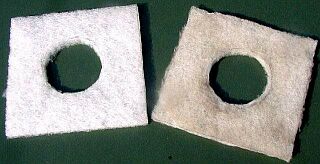 |
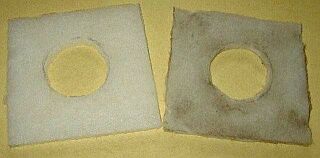 |
|
Picture 1 |
Picture 2 |
The left filter is the new, the right side filter is the used one. The circular hole at the center is because of the fan engine. The two pictures were made of the same filter, worked for one week with different background. The pictures don't tell the shocking feeling, which I felt, when I looked at the filter.
So circulating the air of the room, the filter (if efficient enough) can clean a lot of it, so as a regular "service" the filter should be replaced! The filter I used is washable, so it can be used several times.
In the room, no air movement can be observed.
Behavior at the summer:
In my original plans at the summer period I would cover or uninstall the collector, so not to overheat it. But this was not necessary. I put a thermometer sensor, which can measure up to 110 °C (230 F), into the collecting box, at the output side. Regular checking didn't show higher temperature than 105 °C (221 F). A removed the non-return valve at the input side, this resulted some cooling. Some gravitational air flow could be raised, but I could not measure it (the anemometer could not measure under 0.2 m/s o fair movement).
Once I closed the input side with the help of a pillow, and so higher temperature was showing on the thermometer. Still didn't reach the 110 °C (230 F). After removing the pillow, the "cooling" effect could be felt. I could not measure the temperature at the beer cans wall, here it could be probably higher, but surely below 150 °C (302 F). The most critical element is the glue siloplast, which can resist the heat up to over 200 °C (392 F).
So there was no real need to cover or uninstall the collector, but this is mainly due to the East facing, and the vertical positioning.
It was clear, that the early summer (end of May, early June) and the early autumn (beginning of September) idle, passive measured temperatures were higher, than the June, July and August values. This is because of the Sun's orbit on the sky, it is higher in summer.
Since the whole summer produced really high passive (idle) temperatures (about 100 °C /212 F/) on the collector, it should be considered to use this heat in the summer, and how to use it. Now it is just hanged on the wall !
Real heating season experiences will be available in the next winter.
Original hungarian text: Szentgyörgyi
Péter "sztgyi" - 10 September 2006, Budapest
Translation: Szabolcs Járay (aka jee_c)
Lector & web editor: kpl
